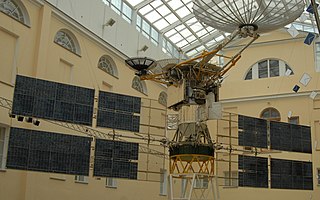
Proton is an expendable launch system used for both commercial and Russian government space launches. The first Proton rocket was launched in 1965. Modern versions of the launch system are still in use as of 2023, making it one of the most successful heavy boosters in the history of spaceflight. The components of all Protons are manufactured in the Khrunichev State Research and Production Space Center factory in Moscow and Chemical Automatics Design Bureau in Voronezh, then transported to the Baikonur Cosmodrome, where they are assembled at Site 91 to form the launch vehicle. Following payload integration, the rocket is then brought to the launch pad horizontally by rail, and raised into vertical position for launch.

The Luch Satellite Data Relay Network (SDRN), also referred to as Altair and Gelios, is a series of geosynchronous Russian relay satellites, used to transmit live TV images, communications and other telemetry from the Soviet/Russian space station Mir, the Russian Orbital Segment (ROS) of the International Space Station and other orbital spacecraft to the Earth, in a manner similar to that of the US Tracking and Data Relay Satellite System.

AMOS is a series of Israeli communications satellites operated by Israel-based Spacecom. All AMOS satellites were developed by Israel Aerospace Industries (IAI) using the AMOS bus satellite bus, except for AMOS-5 which was developed by ISS Reshetnev using the Ekspress bus satellite bus, and AMOS-17 which was developed by Boeing on its BSS-702.

Gonets is a Russian civilian low Earth orbit communications satellite system. It consists of a number of satellites, derived from Strela military communications satellites. The first two satellites, which were used to test and validate the system, were launched by a Tsyklon-3 launch vehicle from the Plesetsk Cosmodrome on 13 July 1992, and were designated Gonets-D. The first operational satellites, designated Gonets-D1, were launched on 19 February 1996. After launch, the first three satellites were given military Kosmos designations, a practice which was not continued with the other satellites.

GLONASS-K is the latest satellite design intended as a part of the Russian GLONASS radio-based satellite navigation system. Developed by ISS Reshetnev and first launched on 26 February 2011, it is a substantial improvement of the previous GLONASS-M second-generation satellites, having a longer lifespan and better accuracy.

The year 2011 saw a number of significant events in spaceflight, including the retirement of NASA's Space Shuttle after its final flight in July 2011, and the launch of China's first space station module, Tiangong-1, in September. A total of 84 orbital launches were conducted over the course of the year, of which 78 were successful. Russia, China and the United States conducted the majority of the year's orbital launches, with 35, 19 and 18 launches respectively; 2011 marked the first year that China conducted more successful launches than the United States. Seven crewed missions were launched into orbit during 2011, carrying a total of 28 astronauts to the International Space Station. Additionally, the Zenit-3F and Long March 2F/G carrier rockets made their maiden flights in 2011, while the Delta II Heavy made its last.

GLONASS-M, also known as Uragan-M are the second generation of Uragan satellite design used as part of the Russian GLONASS radio-based satellite navigation system. Developed by ISS Reshetnev, it had its debut launch in 2003, and is in the process of being phased out. Its production finished in 2015 and its last launch was in November 2022. It is an evolution of the previous Uragan second-generation satellites, improving accuracy, increasing power, extending the design life and adding the FDMA L2OF open signal. The last eight Glonass-M spacecraft in production included the new CDMA L3OC open signal.

This article documents notable spaceflight events during the year 2019.

Notable spaceflight activities in 2017 included the maiden flight of India's Geosynchronous Satellite Launch Vehicle Mark III on 5 June and the first suborbital test of Rocket Lab's Electron rocket, inaugurating the Mahia spaceport in New Zealand. The rocket is named for its innovative Rutherford engine which feeds propellants via battery-powered electric motors instead of the usual gas generator and turbopumps.

This article documents notable spaceflight events during the year 2018. For the first time since 1990, more than 100 orbital launches were performed globally.
Kosmos 2464 is one of a set of three Russian military satellites launched in 2010 as part of the GLONASS satellite navigation system. It was launched with Kosmos 2465 and Kosmos 2466.
Kosmos 2465 is one of a set of three Russian military satellites launched in 2010 as part of the GLONASS satellite navigation system. It was launched with Kosmos 2464 and Kosmos 2466.
Kosmos 2475 is one of a set of three Russian military satellites launched in 2011 as part of the GLONASS satellite navigation system. It was launched with Kosmos 2476 and Kosmos 2477.
Kosmos 2476 is one of a set of three Russian military satellites launched in 2011 as part of the GLONASS satellite navigation system. It was launched with Kosmos 2475 and Kosmos 2477.
Kosmos 2477 is one of a set of three Russian military satellites launched in 2011 as part of the GLONASS satellite navigation system. It was launched with Kosmos 2475 and Kosmos 2476.
Kosmos 2426 is one of a set of three Russian military satellites launched in 2006 as part of the GLONASS satellite navigation system. It was launched with Kosmos 2424 and Kosmos 2425.

Planet Labs PBC is an American public Earth imaging company based in San Francisco, California. Their goal is to image the entirety of the Earth daily to monitor changes and pinpoint trends.
Yamal is a communication and broadcasting system developed and operated by Gazprom Space Systems. Born out of the connectivity needs of the natural gas extraction giant Gazprom, the system was spun off in its own company, and opened the network to third parties and even went into the public broadcasting industry. Yamal and Russian Satellite Communications Company (RSCC)'s Ekspress constellation are the only two national satellite operators in Russia.
Ekspress-AMU1, also known as Eutelsat 36C, is a geostationary communications satellite operated by Russian Satellite Communications Company (RSCC) and designed and manufactured by Airbus Defence and Space on the Eurostar-3000 satellite bus for its Ekspress constellation. It massed 5,892 kg (12,990 lb) at launch, had a power production capacity of 15 kW and a 15-year design life. Its payload is composed of 61 Ku-band and 10 Ka-band transponders.
Ekspress-MD1, was a Russian geostationary communications satellite operated by Russian Satellite Communications Company (RSCC) and designed and manufactured by Khrunichev State Research and Production Space Center on the Yakhta satellite bus for RSCC's Ekspress series. It massed 1,140 kg (2,510 lb) at launch, had a power production capacity of 1300 watts with a C-band and L-band payload.











